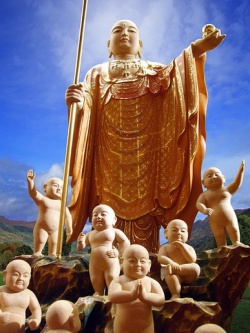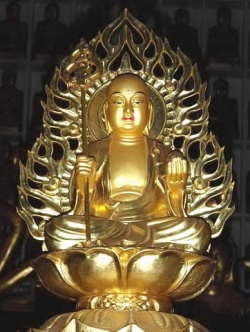Three types of Wisdom
There are three types of wisdom-awareness (shes-rab-gsum), which can be translated as “ordinary knowledge, lesser transcendent awareness, and highest wisdom-awareness.”
They are that which is born of receiving instructions through hearing (thos-pa-las-byung-ba'i-shes-rab), that which is born of reflection (bsam-pa-las-byung-ba'i-shes-rab), and that which is born of meditation (bsgoms-pa-las-byung-ba'i-shes-rab).
There are ten branches of knowledge (rig-pa’i-gnas-bcu) that are studied diligently in the Tibetan tradition so that disciples of the Buddha dharma can eventually and unmistakably realize all three types of prajna.
They are:
(1) rhetoric,
(2) astronomy and astrology,
(3) grammar, (4) performing arts,
(5) semantics,
(6) mechanical arts and handicrafts,
(7) medicine,
(8) phonetics,
(9) dynamics, and
(10) Buddhist philosophy.
They are referred usually as “the ten arts.”
They are divided into five minor (rig-gnas-chung-ba-lnga) and five major disciplines (rig-gnas-che-ba-lnga).
First I will explain the five minor disciplines of study in short.
1) Rhetoric (sgra'i-sbyor-ba) is a branch of linguistics that is studied so that students learn to respect and observe a constant order when formulating their feelings and thoughts in an appropriate way to arouse a similar understanding and appreciation of things with those who are not in the same situation themselves.
2) Astronomy and astrology (skar-rtsis-rig-pa) is a combined field of study in the Tibetan tradition and was derived from Indian sources.
Astronomy is the science that researches the outer universe, the cosmos.
It is the study of the celestial bodies, their magnitudes, motions, constitution, and so forth.
The earth belongs to the inner universe and is called Jambudvipa in Sanskrit, 'dzam-bu-gling in Tibetan.
Living beings are a reflection of appearances and therefore Tibetan astrological charts will always address the correlation between the elements that dominated in the cosmos when someone was born.
The relative locations of planets, the constellations, and other celestial bodies are indicators of the daily rhythms of our global and personal lives.
An astrologer (skar-byed-pa-po) can even describe a client’s father and mother precisely and undeniably.
Astrology is the field of study that calculates the cosmos in conjunction with the human body and the subtle energy forces within the body.
So, next to the outer physical world, there is the outer, physical human body as we know it and the inner body that consists of subtle energies.
Living beings also have a mind that is taken into consideration when a horoscope is made.
These many aspects are interconnected and influence each other. Astrology is the field of study that enables researchers to calculate and enumerate these quite complex connections that constitute life.
A Tibetan calendar sometimes divides a year into 12 months, sometimes into 13.
Sometimes there are only 28 days in a month; often there are 30 days in a month.
It is because Tibetan calendar is based upon the moon’s cycles that determine the four seasons.
Tibetan summer months are always summer and winter months are always winter. Eclipses are also calculated by astrologists and marked in calendars.
There are several systems of astrology, some are called “white” and others are called “black.”
These two general connotations have nothing to do with nether white or black magic, nor do they imply anything that could be considered good or bad.
Black astrology is much more complex and involves more mathematical skill than white astrology.
3) sGra'i-rnam-par-rig-pa, “grammar,” is the study of classes of words, their inflections and syntactical relations, and their functions.
Once there were seven treatises translated from Sanskrit into Tibetan.
They explained the principles of grammar, poetics, metrics, lexicography, and etymology, but five were lost.
Nevertheless, the two texts that are sgra'i-bstan-bcos (“treatises on grammar”) that were not lost are very good and concise.
4) Performing arts and dramaturgy include the study of many topics.
It is the art of learning to vividly recount tales, historical facts, personal stories, or those born from a play-writer’s imagination.
Theatrical performances are representations of events and their background and of persons who were decisive in the lives of many people.
Such performances enable an audience to learn about and appreciate foreign cultures and offer the opportunity to empathize with people living in other parts of the world.
Actors need to know how to speak clearly, dance, sing, and act in ways that move an audience to reflect other times and places as well as other people’s lives.
5) Semantics is the branch of linguistics that investigates the origin and meaning of words (sgra-don).
Many words are explicit, i.e., perfectly clear in meaning (sgra-ji-bzhin), others are implicit and can only be fairly understood though not expressed (sgra-ji-bzhin-pa-yin).
For instance, the Sanskrit term for Buddha was translated into Tibetan as Sangs-rgyas, which is an explicit rendering of the original, i.e., it is a literal translation of the original Sanskrit.
Sangs means “awakened from the sleep of ignorance” and rgyas means “full blossoming of all qualities and knowledge.”
The word “house,” on the other hand, is implicit.
There is a Tibetan dictionary with implicit translations of hundreds of explicit words.
The dictionary states that the word “flower,” for instance, can be called “that which drinks through its feet” or “that which has fine petals.”
The five minor branches of study deal with less complicated topics.
The five major disciplines are more important.
They are mechanical arts and crafts, medicine, phonetics, dynamics and Buddhist philosophy.
6) The first field of major study is mechanical arts and handicrafts (bzo-ba’i-rig-pa in Tibetan, bzo-ba meaning “to build, put up”).
The entire universe is comprised of five elements.
Five substances or principles are needed and support each other so that things can exist.
It is even possible to learn what material things consist of without the help of a teacher.
A potter certainly knows that he needs clay (the principle of solidity) when he wants to make a pot.
He also knows that he needs water (the principle of moisture) and wind in the space in which he turns his potter’s wheel before the pot he made is burned in a furnace.
And so, a potter naturally knows about the five elements (earth, water, wind, fire, and space).
The study of mechanical arts includes becoming skilled in metalwork, carving, painting, weaving, and a host of other creative crafts.
7) The second higher field of study at the greater universities of the Tibetan tradition is gso-ba’i-rig-pa, “the science of healing, medicine.”
The general meaning of gso-ba is “to mend, to feed, to nourish, to enhance.”
While studying the first art of higher education, they learn how things are made. Medical training is the study of how living bodies function.
When the physical body doesn’t function, we diagnose and treat a patient with medicine.
There are many ways of diagnosing a sickness and disease.
If a Tibetan doctor is not able to immediately find the cause of an illness, he will test ten remedies that he could prescribe after having diagnosed a sickness.
He makes a diagnosis by adding a sample of one of each ten possible remedies to each sample of urine that a patient filled into ten separate jars.
A physician will then carefully observe what happens in each jar, will then be able to recommend a medicine and treat his patients effectively.
The organs of the human body correspond to specific herbs, which grow on mountain slopes or meadows.
Tibetan traditional medicine is biological and non-invasive.
8) The third higher field of study is phonetics (sgra’i-rig-pa), the science that investigates the formation of sounds by the speech organs and apprehension by the ear so that individuals understand the art of speech as well as the application to the understanding and speaking of languages.
Phonetics is often thought to be the study of the Sanskrit alphabet, but it is much more – it is an ornament, sgra’i-rgyan that adorns someone who has become open and flexible through communicating with others fairly.
Phonetics is the study of all the elements, movements, feelings, environment, and sounds that can be heard.
9) Dynamics is the branch of science that studies movements and vibrations, which make sounds.
One aspect of knowledge learned through the study of dynamics is electronics, a field of physics that studies how televisions, radios, and telephones are made and function.
Another branch of physics is kinetics, which enables us to watch someone we are speaking with over the phone and who is at the earth’s other side, as though that person were in the same room.
Dynamics and electronics are the study of vibrations occurring in an environment and the physical properties of sounds.
10) Buddhist philosophy is often described as the study of logic (pramana in Sanskrit, tshad-ma’i-rig-pa in Tibetan).
Logic is the very complicated study of the two levels of truth; (bden-gnyis) that are nominally distinct, i.e., ultimate truth (don-dam-bden-pa) and relative truth (kun-rdzob-kyi-bden-pa).
It takes 10 to 15 years of determination and rigorous study on the side of a student to master the higher science of pramana correctly.
Perfecting ten branches of wisdom we learn how everything is made, how things function, and the interconnectedness of all things.
Mastering the minor and major fields of study is the way a practitioner learns external knowledge, rig-gnas-kyi-phyogs.
Lesser transcendent awareness is acquired by research of two truths from the relative angle only, and therefore it is a one-sided approach.
It is marked by realization of the ten virtuous actions.
A disciple who has attained a very good understanding of transcendent awareness knows that non-virtuous actions cause suffering and virtuous actions lead to happiness, but such understanding is still dualistic since the ultimate is still seen as the other side of a coin, a goal that a practitioner aspires to achieve.
A practitioner who has lesser transcendent awareness has transcended samsara but has not attained the supreme dharmakaya that is the inseparable two truths, bden-gnyis-dbyer-med-lhag-pa'i-chos-sku-che.
Highest wisdom-awareness is realization of freedom from dualistic attachments of any kind.
It is ineffable since it is beyond a subject-object dichotomy.
Knowing how things function is the first stage of practice, knowing how they really are is the second stage, and realizing the indivisibility of the relative and absolute truths is the third stage that sincere disciples of Mahayana and Vajrayana eventually realize.
Wisdom-awareness can only be roughly described through language usage, while in reality it can only be experienced.
Everyone has to taste it for him or herself.



